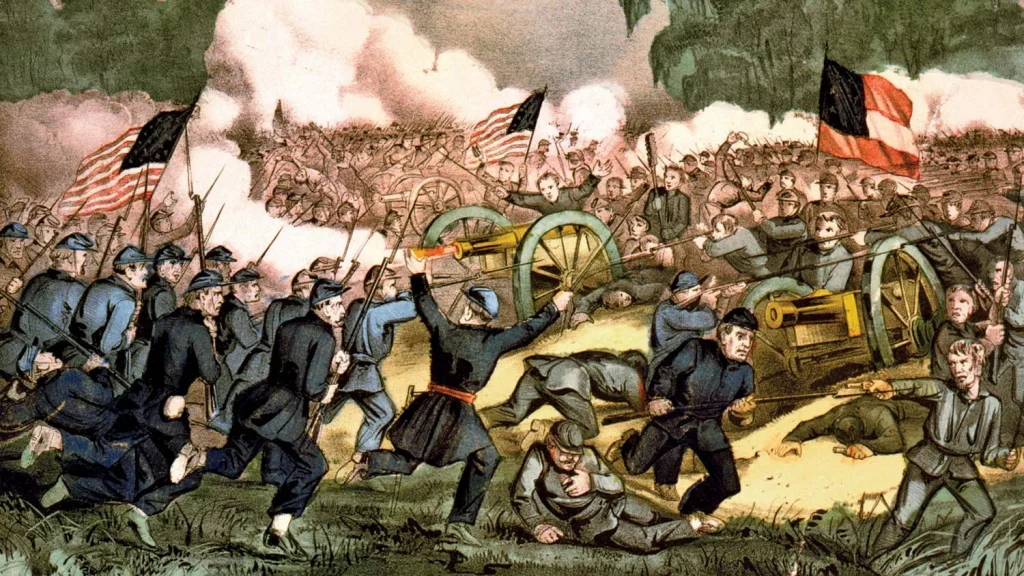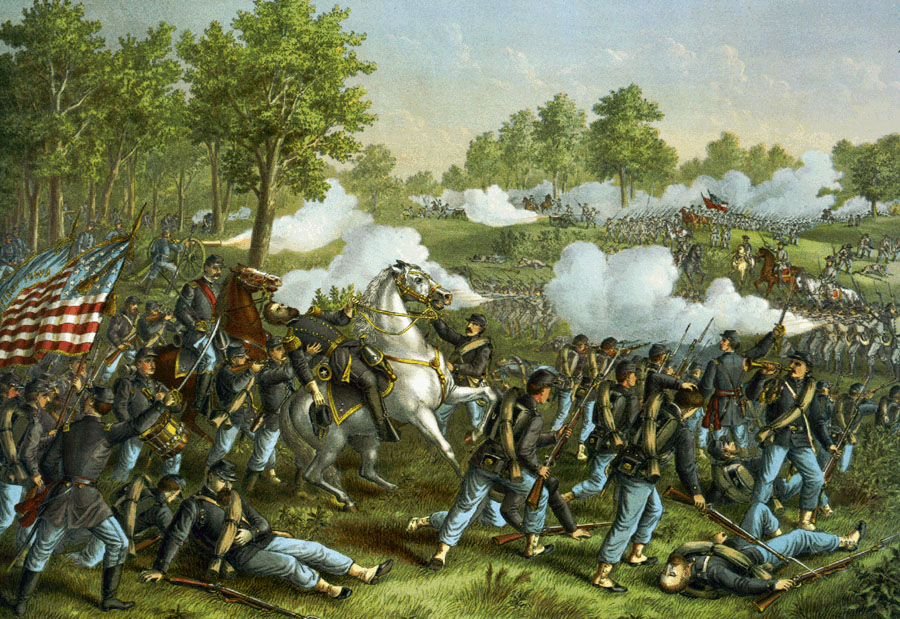The beginning of the year turned out to be unsuccessful for the Federation: the next attack on Richmond by a 130,000-strong army turned into a complete defeat from half the size of Lee’s army. The battle lasted six days, and the total losses of the parties amounted to 18.5 thousand killed and wounded.
Taking into account the mistake of the year before last, Lee launched a counterattack on Washington, but was stopped by the army of General George Meade, the new commander of the North. From July 1 to July 3, 1863, the famous Battle of Gettysburg took place. The battle was extremely fierce – the Southerners sought to win a final victory, and the Northerners fought for the first time on their own land. As a result, the Confederates retreated, having lost 27 thousand people killed and wounded. The losses of the Northerners were a little less, so they could not pursue the enemy and build on their success.

At the same time, on the western front, Federation troops scored another important victory: they managed to capture the fortress of Vicksburg in Louisiana. Now the North controlled the entire Mississippi Valley, and the Confederacy was divided into two parts.
By the end of 1863, all the military and financial resources of the Confederation were running out, but the morale of the Southerners was still strong: they put up fierce resistance to the army of the North, now and then throwing it back.
In 1864, the commander-in-chief of the US Army, Ulysses Grant, developed a plan for the final defeat of the Confederacy. The first blow was to be delivered by General William Sherman: he entered Georgia, and regardless of the losses, destroying everything in his path, he moved to the Atlantic Ocean.
Grant himself, with an army of 118,000, attacked in the east, meeting with enemy troops in the Wilderness forest. In the battle in the Wilderness, Grant lost 18 thousand people, but this did not stop him. With bloody battles and huge losses, he broke through until he was stopped by General Lee in the 13-day Battle of Cold Harbor (May 31 – June 12). Having failed to gain the upper hand, Grant withdrew and laid siege to the city of Petersberg. This siege lasted for almost a year.
Meanwhile, Sherman’s army fought its way to the Atlantic coast.
By December he had occupied the coastal cities of Atlanta and Savannah and then turned to link up with Grant’s forces.
By the spring of 1865, Grant had over 115,000 men at his disposal, while Lee had only 54,000. His army began to retreat, but was surrounded. On April 9, General Lee, with the remnants of his army, surrendered to Grant at the Appomattox River.
Five days after the surrender of the Army of the South, President Lincoln was assassinated. On April 14, 1865, he was shot dead by Southern supporter John Booth in the box of Ford’s Theatre.
On May 10, with the arrest of Jefferson Davis and other members of the government, the Confederate States of America ceased to exist. Separate units of the CSA still continued to resist, but by August 1865 the war was over..
The American Civil War was the bloodiest conflict in the history of the nation: 600,000 dead and 400,000 missing.
The main result of the war was the famous 13th Amendment to the US Constitution, which abolished slavery throughout the country. This was a major step towards equality in American society.
At the same time, the amendment did not provide the former slaves with even minimal property: they were simply expelled from the plantations, leaving them to the mercy of fate. This led to an increase in crime in the war-torn states. To restore order, the white population began to unite in armed organizations, one of which was the infamous Ku Klux Klan.

The armies of the Federation on the territory of the rebellious states behaved like invaders: they destroyed plantations with already harvested crops, burned villages, smashed cities. It took more than a decade for the US economy to recover from the Civil War. The troops were withdrawn from the states of the former Confederation only in 1877.
Despite all the dire consequences, the American Civil War brought a number of positive changes:
- The government managed to preserve the integrity of the country.
- The abolition of slavery was the first step towards equalizing the rights of the white and black population.
- The centralization of power and the strengthening of the domestic market subsequently made the United States one of the most developed countries in the world.
- The war tempered the American army and contributed to the development of military affairs.
An important feature of the American Civil War was the use of the latest advances in technology. Machine guns, mines, observation balloons and battleships, ramming ships and even submarines were first used in large-scale hostilities and proved their effectiveness.
